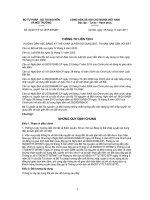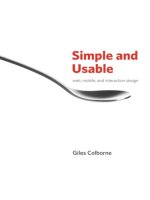e3 chap 05 Interaction Design Basics
Bạn đang xem bản rút gọn của tài liệu. Xem và tải ngay bản đầy đủ của tài liệu tại đây (18.48 MB, 92 trang )
chapter 5
interaction design
basics
interaction design basics
• design:
– what it is, interventions, goals, constraints
• the design process
– what happens when
• users
– who they are, what they are like …
• scenarios
– rich stories of design
• navigation
– finding your way around a system
• iteration and prototypes
– never get it right first time!
interactions and interventions
design interactions not just interfaces
not just the immediate interaction
e.g. stapler in office – technology changes interaction style
• manual:
• electric:
write, print, staple, write, print, staple, …
write, print, write, print, …, staple
designing interventions not just artefacts
not just the system, but also …
• documentation, manuals, tutorials
• what we say and do as well as what we make
what is design?
what is design?
achieving goals within constraints
• goals - purpose
– who is it for, why do they want it
• constraints
– materials, platforms
• trade-offs
golden rule of design
understand your materials
for Human–Computer Interaction
understand your materials
• understand computers
– limitations, capacities, tools, platforms
• understand people
– psychological, social aspects
– human error
• and their interaction …
To err is human
• accident reports ..
– aircrash, industrial accident, hospital mistake
– enquiry … blames … ‘human error’
• but …
– concrete lintel breaks because too much weight
– blame ‘lintel error’ ?
… no – design error
we know how concrete behaves under stress
• human ‘error’ is normal
– we know how users behave under stress
– so design for it!
• treat the user at least as well as physical materials!
Central message …
the user
The process of design
what is
wanted
interviews
ethnography
scenarios
task analysis
guidelines
principles
analysis
precise
specification
design
what is there
vs.
what is wanted
dialogue
notations
evaluation
heuristics
prototype
implement
and deploy
architectures
documentation
help
Steps …
• requirements
– what is there and what is wanted …
• analysis
– ordering and understanding
• design
– what to do and how to decide
• iteration and prototyping
– getting it right … and finding what is really needed!
• implementation and deployment
– making it and getting it out there
… but how can I do it all ! !
• limited time design trade-off
• usability?
– finding problems and fixing them?
– deciding what to fix?
• a perfect system is badly designed
– too good too much effort in design
user focus
know your user
personae
cultural probes
know your user
•
•
•
•
•
who are they?
probably not like you!
talk to them
watch them
use your imagination
persona
• description of an ‘example’ user
– not necessarily a real person
• use as surrogate user
– what would Betty think
• details matter
– makes her ‘real’
example persona
Betty is 37 years old, She has been Warehouse Manager for five
years and worked for Simpkins Brothers Engineering for twelve
years. She didn’t go to university, but has studied in her
evenings for a business diploma. She has two children aged 15
and 7 and does not like to work late. She did part of an
introductory in-house computer course some years ago, but it
was interrupted when she was promoted and could no longer
afford to take the time. Her vision is perfect, but her right-hand
movement is slightly restricted following an industrial accident 3
years ago. She is enthusiastic about her work and is happy to
delegate responsibility and take suggestions from her staff.
However, she does feel threatened by the introduction of yet
another new computer system (the third in her time at SBE).
cultural probes
• direct observation
– sometimes hard
• in the home
• psychiatric patients, …
• probe packs
– items to prompt responses
• e.g. glass to listen at wall, camera, postcard
– given to people to open in their own environment
they record what is meaningful to them
• used to …
– inform interviews, prompt ideas, enculture designers
scenarios
stories for design
use and reuse
scenarios
• stories for design
– communicate with others
– validate other models
– understand dynamics
• linearity
– time is linear - our lives are linear
– but don’t show alternatives
scenarios …
• what will users want to do?
• step-by-step walkthrough
– what can they see (sketches, screen shots)
– what do they do (keyboard, mouse etc.)
– what are they thinking?
• use and reuse throughout design
scenario – movie player
Brian would like to see the new film “Moments of Significance”
and wants to invite Alison, but he knows she doesn’t like “arty”
films. He decides to take a look at it to see if she would like it
and so connects to one of the movie sharing networks. He uses
his work machine as it has a higher bandwidth connection, but
feels a bit guilty. He knows he will be getting an illegal copy of
the film, but decides it is OK as he is intending to go to the
cinema to watch it. After it downloads to his machine he takes
out his new personal movie player. He presses the ‘menu’
button and on the small LCD screen he scrolls using the arrow
keys to ‘bluetooth connect’ and presses the select button. On
his computer the movie download program now has an icon
showing that it has recognised a compatible device and he drags
the icon of the film over the icon for the player. On the player
the LCD screen says “downloading now”, a percent done
indicator and small whirling icon. … … …
also play act …
• mock up device
• pretend you are doing it
• internet-connected swiss army knife …
but where is that thumb?
use toothpick as stylus
… explore the depths
• explore interaction
– what happens when
• explore cognition
– what are the users thinking
• explore architecture
– what is happening inside
use scenarios to ..
• communicate with others
– designers, clients, users
• validate other models
– ‘play’ it against other models
• express dynamics
– screenshots – appearance
– scenario – behaviour









